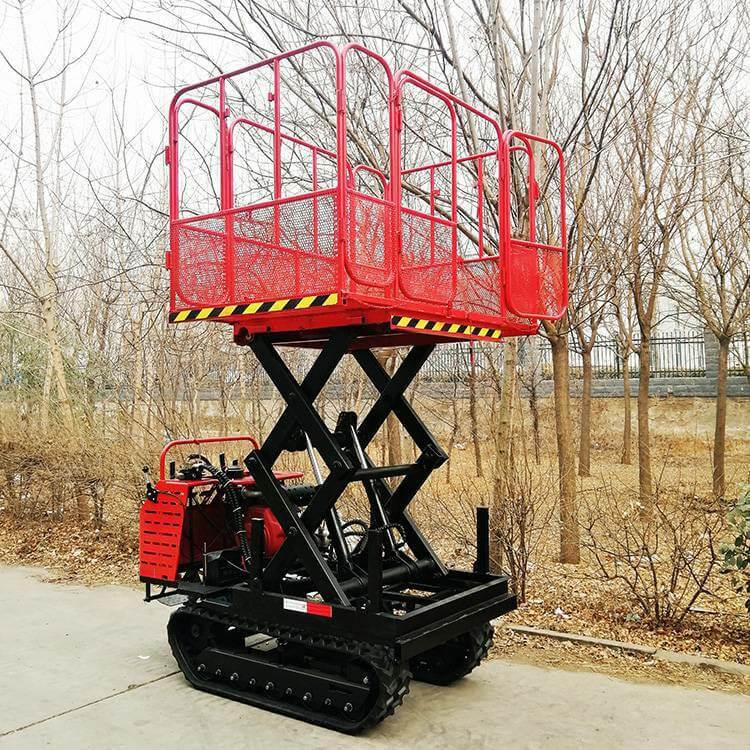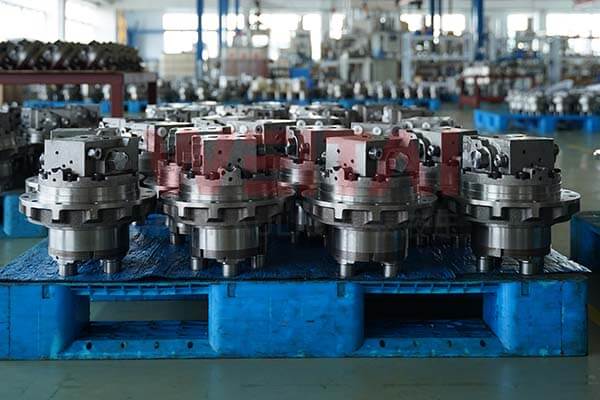Wide Application of Hydraulic Motors in Crawler Lifts
Hydraulic motors play a vital role in crawler lifts. The control valve group and control system of the crawler chassis driven by hydraulic motors illustrate the key role of hydraulic motors in crawler lifts. Its speed control module includes safety valves, pressure compensators, damping holes, and proportional speed control valves. These components work together to ensure the stable operation of the hydraulic system and the efficient operation of crawler lifts.
The wide application of hydraulic motors in crawler lifts provides powerful power support for various high-altitude operations and engineering construction, highlighting its important position in this field.

Unique Advantages of Hydraulic Motors
1. High precision and high speed
Hydraulic motors have high speed, precision, reliability, and stable and reliable operation. Its operating accuracy can reach 0.01 mm and performs well for high-speed or multi-speed driven equipment. For example, high-speed servo motors can provide a response speed of up to 1ms/s, which can meet the rapid response requirements of multiple servo devices under heavy loads. At the same time, because the motor adopts the electromagnetic transmission principle, it has a high anti-interference ability. The high speed is because the motor provides strong rigidity and fast switching ability, so there is no torque loss when running at low speed; there is no torque loss when running at high speed.
2. Simple structure and low cost
The hydraulic motor has a simple structure and low manufacturing cost. Its basic principle is to realize the working direction conversion and control function of the engine through the reciprocating motion of the hydraulic oil in the press. It is mainly composed of actuators and auxiliary components. In the actuator, the driven motor rotor rotates, and the rotor is a very rigid component. Compared with mechanical transmission, the hydraulic motor generates almost no torque when working; no additional torque is consumed; there is no load output even when the working point is as low as 0.05° and 0.03°; the hydraulic cylinder has a small volume, and high speed; the rotating parts are insulated from each other to prevent vibration and friction; the output speed is fast and smooth; the operation is smooth and the angle rotation can be carried out with high control accuracy. In addition, it is very convenient to use liquids such as hydraulic oil, and these liquids will not pollute the environment even if they are not located on the motor. When working, these liquids will not pollute the environment. This is why many large mechanical equipment use hydraulic motors instead of mechanical transmission elements to achieve their high efficiency and range of motion.
3. Large torque and good stability
Hydraulic motors have the advantages of large torque, good stability, high reliability, wide speed regulation range, strong load capacity, and strong adaptability. Hydraulic motors usually have large torque output capacity and can meet the working requirements under large loads. Since the liquid transmission method of hydraulic motors is smoother than mechanical transmission, they have higher stability and stability. There is no transmission chain inside the hydraulic motor, which is simpler than mechanical transmission, so it has higher reliability and life. The hydraulic motor can adjust the speed by changing the flow and pressure in the hydraulic transmission, so it has a wide speed regulation range and strong adaptability. Since the hydraulic motor has the characteristics of large torque and good stability, it can withstand large loads and working resistance. The hydraulic motor can adapt to different working conditions and working environments through different structural designs and adjustment of hydraulic system parameters. In short, these characteristics make the hydraulic motor play an important role in crawler lifts.
Improvement of Crawler Lift Performance by Hydraulic Motors
1. Adjustment of lifting speed
Hydraulic motors play a key role in adjusting the lifting speed of crawler lifts. The adjustment of lifting speed can be achieved through a variety of methods. First of all, adjusting the power unit is a common method. Whether it is a scissor lift or a rail lift, it is controlled by a power unit and a cylinder. The power unit is equipped with four outlets during production, and the size can be adjusted. To increase or decrease the hydraulic oil flow of the cylinder, the motor speed or the electro-hydraulic proportional valve can be adjusted to adjust the hydraulic oil flow. Secondly, oil pipe control is also very important. The longer the hydraulic oil pipe, the longer the rising time. Therefore, during installation, the length of the oil pipe should be reduced as much as possible within the design allowable range; the size of the oil pipeline can also be adjusted based on adjusting the power unit, and the corresponding adjustment can be made on the premise of ensuring that the equipment meets the normal demand safety. In addition, the size of the oil cylinder will also affect the lifting speed. While meeting the design requirements, reduce the size of the oil cylinder as much as possible. The smaller the size of the oil cylinder, the faster the rising speed.
2. Ensure the load capacity
The matching relationship between the hydraulic pump flow and the hydraulic motor is crucial to ensure the load capacity of the crawler lift. If the flow of the hydraulic pump is less than the flow required by the hydraulic motor, it may cause the system performance to decline. In this case, the working speed of the system will decrease and the movement speed of the load will slow down. At the same time, the pressure of the hydraulic system is related to the load, not the flow. However, too small a flow rate will lead to poor system stability and intermittent oil flow, such as creeping or shaking of the hydraulic motor. Some hydraulic systems are equipped with overload protection devices. When the system load exceeds the flow rate that the hydraulic pump can provide, this device will brake the system to prevent damage to the hydraulic components. When designing a hydraulic system, it is important to ensure that the flow rate of the hydraulic pump can meet the needs of the hydraulic motor and the entire hydraulic system. If there is a mismatch, the hydraulic system needs to be redesigned, such as replacing the hydraulic pump, increasing the engine or motor power, etc., to ensure the normal operation of the system.
3. Energy saving and efficiency improvement
Hydraulic motors can achieve energy saving and efficiency improvement from aspects such as design optimization, system matching, and oil management. In terms of design optimization, efficient hydraulic motors should have lower leakage rates and higher mechanical efficiency. By using advanced manufacturing technology and materials, and improving the design of the internal components of the motor, such as more optimized rotor and stator shapes, energy losses can be significantly reduced. In addition, the use of high-precision seals and accessories can effectively reduce the leakage of hydraulic oil and further improve overall efficiency. In terms of system matching, the selection of hydraulic motors must match the needs of the actual application to ensure that the motor operates in the optimal efficiency range. Reasonable motor selection can avoid overload and inefficient operation, which not only saves energy but also prolongs the service life of the equipment. At the same time, the intelligent control system can monitor the operating status of the hydraulic motor in real-time, automatically adjust the working parameters according to the load conditions, achieve dynamic optimization, and further enhance the energy efficiency of the system. In terms of oil management, high-performance hydraulic oil can reduce friction loss and improve transmission efficiency. Regularly replace and filter the hydraulic oil to maintain the cleanliness and performance of the oil and avoid the accumulation of impurities that lead to additional energy loss. Reasonable oil temperature control is also crucial because too high or too low oil temperature will affect the working efficiency and safety of the hydraulic motor.

The Specific Role of Hydraulic Motors in Crawler Lifts
1. Driving the walking system
The hydraulic motor plays a key role in driving the walking system in crawler lifts. Crawler lifts usually need to work in various complex terrain environments, and hydraulic motors can provide powerful power to ensure that the lift has good mobility. The crawler lift has a walking system driven by a hydraulic motor, and the steering walking system is uniformly controlled by an integrated hydraulic pump station. This design enables the lift to travel smoothly under different ground conditions, whether it is a rugged mountain road or a muddy construction site, it can easily cope with it.
According to the searched materials, the hydraulic motor has the characteristics of high torque and good stability, which can meet the large load requirements of the crawler lift during the walking process. For example, the hydraulic motor can play an important role in a crawler vehicle weighing one and a half tons. To determine the size of the hydraulic motor required for a crawler vehicle weighing one and a half tons, factors such as the vehicle’s moving speed requirements, thrust requirements, and the efficiency of the hydraulic system need to be considered. Through reasonable calculation and selection, it can be ensured that the hydraulic motor can provide sufficient power for the crawler lift so that it can travel smoothly in various working scenarios.
2. Provide stable support
The hydraulic motor can not only drive the walking system but also provide stable support for the crawler lift by cooperating with other components. In the working process of the crawler lift, stability is crucial, which is directly related to the safety and work efficiency of the operator. The stability and reliability of the hydraulic motor enable it to work in conjunction with other components of the lift to provide strong support for the lift.
For example, the lower chassis of a crawler lift usually supports four double-acting cylinders as hydraulic legs, which, driven by a hydraulic motor, can make the lifting process more stable. At the same time, the hydraulic motor has a strong load capacity and can withstand large weights and working resistance, providing stable support for the crawler lift. In addition, the hydraulic motor has a wide speed regulation range and can adjust the lifting speed and support strength according to different work requirements to ensure that the lift can remain stable under various working conditions.
3. Realize intelligent control
The hydraulic motor cooperates with a microcomputer to realize the intelligent control of the crawler lift and improve work efficiency and safety. Modern crawler lifts are usually equipped with a microcomputer control system, which analyzes the sensor data installed in various parts of the lift body to derive the working status of the lift and accurately control the hydraulic motor.
For example, through an intelligent control system, the speed, torque, and direction of the hydraulic motor can be accurately controlled, thereby realizing the precise lifting and walking of the crawler lift. At the same time, the intelligent control system can also monitor the working status of the hydraulic motor in real-time, such as parameters such as temperature, pressure, and flow, and can issue an alarm in time and take corresponding protective measures once an abnormal situation is found. In addition, the intelligent control system can also optimize the control of the hydraulic motor according to different work requirements, improve energy utilization, and reduce operating costs.
Summary
In summary, hydraulic motors play a vital role in the performance, function, and safety of crawler lifts. It not only improves the working efficiency and reliability of crawler lifts but also provides a strong guarantee for the safety of operators. In future development, with the continuous advancement of technology, the application of hydraulic motors in crawler lifts will be more extensive and in-depth, making greater contributions to the development of various fields.
Post time: Nov-11-2024
